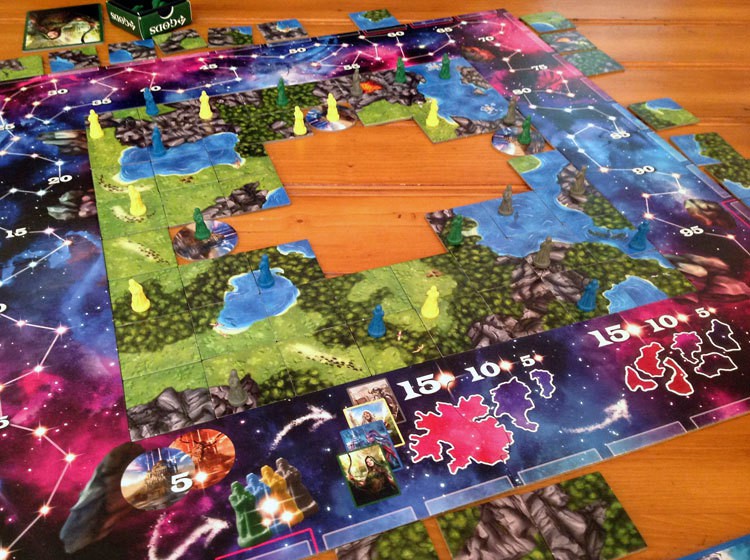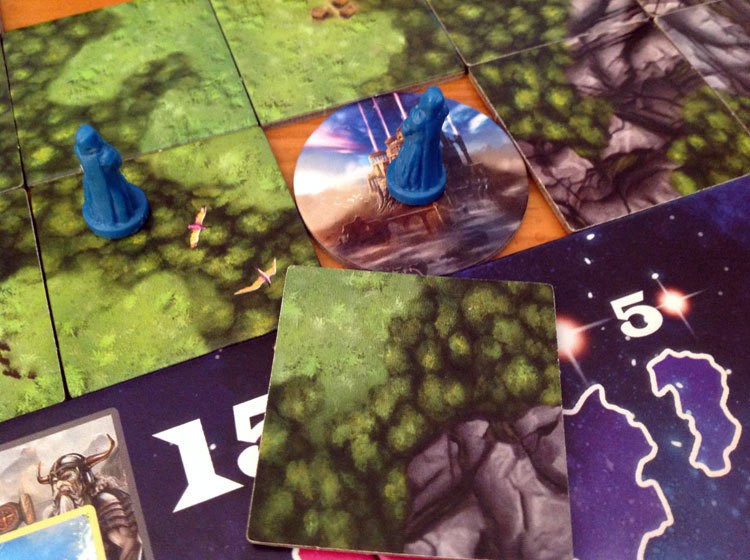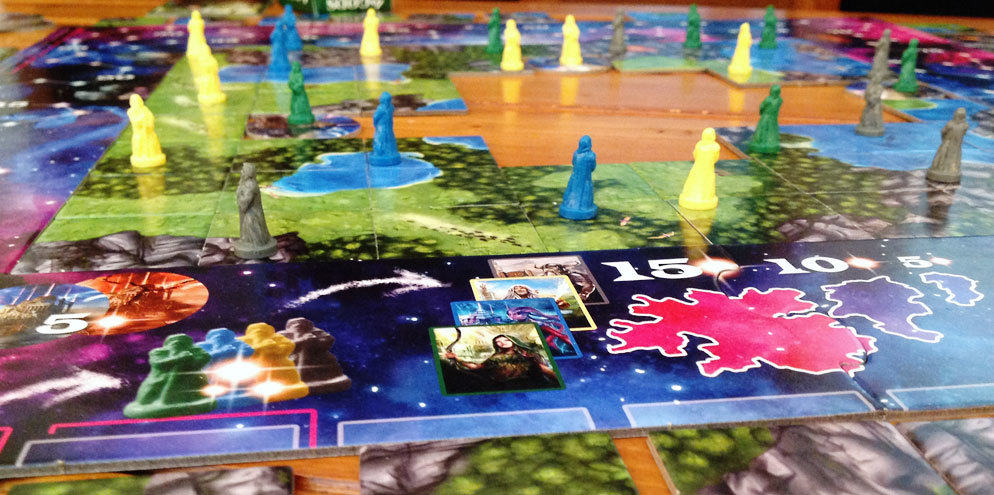 I love Carcassonne. There, I’ve said it, and I’m not ashamed to admit it. Carcassonne was one of the first games I learned when I entered the hobby, and I still enjoy playing it to this day. Whether it’s the base version, or any of the “spin-off” flavors, the act of drawing tiles and placing them on the table into an ever-expanding landscape always brings a smile to my face.
I love Carcassonne. There, I’ve said it, and I’m not ashamed to admit it. Carcassonne was one of the first games I learned when I entered the hobby, and I still enjoy playing it to this day. Whether it’s the base version, or any of the “spin-off” flavors, the act of drawing tiles and placing them on the table into an ever-expanding landscape always brings a smile to my face.
Now, imagine a game of Carcassonne where everyone is drawing tiles, trying to place them correctly and strategically on the table, and claiming them with your player figures AT THE SAME TIME. Well, that game would be called 4 Gods, and coincidentally, it would also be the game I am reviewing right now…
4 Gods is a real-time tile laying game with area control aspect for 2 to 4 that plays in about 30-40 minutes.
Game Overview:
In 4 Gods, players assume the roles of gods who are trying to create a new world by placing tiles that represent the landscape. They are also competing to have the most influence by assigning their prophets to different areas of the new world. The unique aspect of this game (in its normal mode) is that it plays out in real time, with all players taking their turns simultaneously. When the game ends, the new world is evaluated and points are earned in several ways. The player with the most victory points is the winner.
Game Components:
Since this is a tile laying game, it’s no surprise that the main component in the game is a set of almost 100, 2-sided square landscape tiles, showing an assortment of 4 terrain types: oceans, forests, mountains and plains. The tiles are placed in a velvet drawbag.
A 4-piece cardboard frame is assembled in the center of the table, which designates the area into which the drawn tiles will be placed. There are 4 large tiles representing the 4 gods (each one having dominion over one of the terrain types), and 4 sets of plastic Prophet miniatures, matching each god’s color. There are also 8 circular tiles depicting legendary cities, a set of tokens representing the various game modes that can be played, and a sand timer (for the timed variant).
How to Play:

After assembling the frame, and placing the god tiles, prophet boxes and legendary city tokens on the table within reach, each player draws 2 tiles from the bag and holds one in each hand. Once everyone is ready, a player announces the start of the game. At this point, everything is played in real time and simultaneously.
Placing the tiles on the table within the frame is the most common action that can be taken, and as in the game Carcassonne, the terrain on a placed tile must match the terrain on all adjacent tiles.
If a player cannot see a legal place to place a tile at the moment, the tile can be discarded into one of the discard spaces on the side of the frame closest to that player.
If a player has both hands free, he may take the drawbag and draw one or two new tiles from it.
Players do not start the game with any particular god/prophet set, but at some point, they will want to claim an available set. Once a player claims a god and prophets, they have a few additional actions they may take.
Immediately after placing a tile, a player may place one of his prophets on that tile, claiming one of the specific terrains on it. As a terrain area grows through further tile placement, the player or his opponents may place prophets within the same terrain area in order to gain majority there.
Another important action that can be taken, once a player claims a god, is the placement of a legendary city tile. A player may take one city tile and place it anywhere within the frame, as long as it touches two straight sides of adjacent tiles. Once a legendary city tile is placed, the player must place a prophet on it, to claim it.
Lastly, a player may decide to destroy a legendary city of another player, if they possess a tile that could be legally placed in the space where the legendary city currently resides.
Players continue to take these actions simultaneously, until one of the following occurs: the world frame is completely filled with terrain tiles and legendary cities, the drawbag is empty, or all players agree that there are no more legal placements left to be made with the tiles remaining in the players’ hands and/or their discard rows.
At this point, the game ends, and the players calculate their scores and the player with the most points is the winner.

Game Experience:
It’s sort of ironic that my most recent game review for Board Game Quest was for Tumult Royale, a real-time tile grabbing game, and in that review, I mentioned that I am not a big fan of real-time games. I still stand by that statement, but I have to admit that I’ve had a lot of fun playing 4 Gods. I’m assuming that’s because I enjoy Carcassonne so much, and this game almost feels like a Carcassonne cousin, with a twist.
For a Carc fan like me, who is used to drawing one tile at a time, and then carefully planning where to place it for maximum scoring, the simultaneous, race-against-the-clock gameplay in 4 Gods is a pretty clever step up from good ol’ Carc.

Here’s something else I’ve mentioned in past reviews: the concept of “good frustration”. This game gives me that feeling every time I’ve played it. For a game with such simple rules, I was (pleasantly) surprised at how challenging it can be to find ANY legal spot for a terrain tile, let alone a maximum scoring spot. Actually, it’s not too much of a problem at the beginning of the game, when the world frame is wide open, and players are laying down tiles at a quicker pace.
I remember thinking in my first game, “I’ll never need all of these discard spaces! I play Carcassonne…I’m an expert at tile laying! Besides, the tiles are all 2 sided – how hard can it be?” However, once the frame starts filling in, it’s pretty tough to find a space that will accept your tile, and you inevitably do start discarding tiles, one after the other… The “good” portion of the “good frustration” concept comes when you do find a spot to place your tile, or better yet, you can see the perfect place for a tile that’s in your opponent’s discard row. Grabbing that tile away from them, placing it properly, and dropping a prophet on it is so satisfying.
Speaking of satisfying, placing a legendary city – or more accurately, destroying another player’s legendary city – is pretty satisfying as well. Finding a tile that fits perfectly in a space occupied by an opponent’s legendary city is a great “Aha!” moment. There are a couple ways that you can prevent your own legendary city from being destroyed, and I like that the rule book actually mentions them in a “tips” section. (I make a point of explaining these tips when teaching the game, in the interest of fairness.)
Since any terrain tile only contains 3 of the 4 terrain types on it, a legendary city that is bordered by all 4 terrain types will never be able to be replaced, since there is no tile that can legally replace it. In addition, if a legendary city is bordered by 2 terrain types that meet at a corner with 2 different tiles, it will be impossible to put a tile in its place in this situation as well. A smart player will look for these opportunities (or create them himself) as the world frame fills in, in order to place a legendary city that will be permanent.

I also enjoy the way in which terrain areas are scored at the end of the game. It’s another nice twist in the Carcassonne formula: you want to claim an area, and you want the area to be comprised of many tiles, AND you want to have the majority of prophets in the area at the end of the game. However, it’s a kind of balancing act at the same time.
Overloading an area with your prophets will have a negative effect during scoring, since you lose 1 point for every tile with a prophet on it. When I first played a demo of this game at GenCon 2016, two of the other players were fighting back and forth for a large ocean area, and at the end of the game, they wound up being tied for majority (in which case they both receive the full score for that area). But because they both placed so many prophets in that one area, it was basically worthless, and they might have been better off spreading out their prophets into multiple areas.
The god selection process is another well-thought-out part of the game. At first it might not seem important which god you choose. However, if you are able to plan carefully (throughout all the real-time chaos), ensuring that your terrain type comprises the largest area on the board and/or the largest number of separate areas can gain you a lot of points.
Although this game is designed to be played in real-time, the designer does offer a few variants from the “normal” mode of play. If the players want to, they can play in a “timed turn” mode, in which each player gets 30 seconds (timed by the sand timer) to perform as many actions as they wish. This does help eliminate, or at least reduce, the number of misplaced tiles (more on that in a bit), but this variant feels a little too close to a normal game of Carcassonne in my opinion, so I can’t see myself playing this way.

As much as I’ve been enjoying 4 Gods, there are a few very minor nitpicks I have with it. The first has to do with incorrectly placed tiles. In a real-time game, this is bound to happen, and the rule book offers a few suggestions on how to resolve it. However, since the very nature of the game is real-time, it can be difficult to sort out a badly placed tile situation in the middle of the game by using the rules as they are presented.
My suggestion is to not worry about it until the end of the game. If players encounter a misplaced tile during scoring that has a player’s prophet on it, that prophet will not be counted in the scoring. The other glitches I’ve encountered in the game also have to do with the real-time aspect of it. Since everyone is frantically drawing and placing tiles at the same time, the board can get jostled pretty easily, and the small prophets can become shifted from their intended terrain area on a tile. As I said, these are all minor nitpicks, and if all players understand upfront that these things can happen in a real-time game, you shouldn’t let them distract you from a fun time.
Final Thoughts:
When I first sat down to play 4 Gods at GenCon, I couldn’t believe that no one (to my knowledge) has ever attempted a real-time variation on Carcassonne. I wasn’t sure how well it would work, but after only a few minutes into the game, I was hooked.
Your brain has to work pretty fast in order to scout all possible locations for a tile, and as disappointed as you are when you resign yourself to discarding a tile, you can be pretty satisfied with yourself when you find a use for an opponent’s discarded tile. The designer of 4 Gods, Christophe Boelinger, has also designed a game called Archipelago, which is a heavy beast of a game. So it’s refreshing to see that he’s also capable of designing a game that’s much lighter, but still a whole lot of fun. Whether or not you are a Carcassonne lover, I recommend giving 4 Gods a try if you get the chance.
If you’d like to get a copy of 4 Gods, you can pick it up for about $50.
Final Score: 4.5 stars – A great mash up of some familiar tile-laying mechanics with a fun real-time element.
 Hits:
Hits:
• Incredibly easy to teach
• A nice step up from Carcassonne, with a few clever rules twists.
• Decent quality components
• Has that “good frustration” factor when scrambling to place a tile in the perfect spot.
Misses:
• Slightly wonky rules on misplaced tiles.
• Since this is a real-time game, there are opportunities for errors, jostled tiles, moved prophets, etc.






















